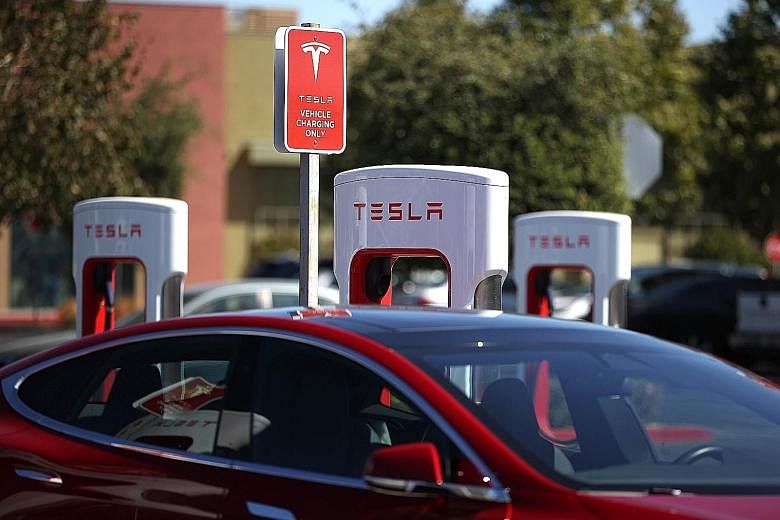NEW YORK • Tesla, billionaire Elon Musk's 17-year-old upstart carmaker, took a giant step towards blue-chip respectability on Monday, getting named to one of the world's most famous stock indexes in an action that will greatly broaden its investor base.
The announcement that Tesla will enter the S&P 500 on Dec 21 follows months of speculation and one temporary setback, after the stock failed to make the cut during the index's quarterly rebalancing in early September.
The anticipation has helped drive a nearly fivefold rally in the stock this year to almost US$390 billion (S$525 billion), making the electric vehicle pioneer the biggest company ever to be added to the gauge. It will also be one of the index's most influential constituents, with a weighting that falls around those of Berkshire Hathaway, Johnson & Johnson and Procter & Gamble.
It is so big that S&P Dow Jones Indices said it is seeking feedback from the investment community to determine if Tesla should be added all at once or in two separate pieces.
The company that Tesla is to replace in the index will be named later, the index provider said.
Tesla shares rose as much as 15 per cent to US$467.50 on Monday in extended New York trading on the news.
While entry into the benchmark is a rite of maturity that may dim some of Tesla's cult stock appeal, membership comes with benefits, including forced purchases by index-tracking investors and mutual funds.
The inclusion and the rapid rally over the past few months mean money managers overseeing passive funds will have to sell tens of billions of dollars worth of shares in their existing S&P holdings to make room for Tesla.
On the other hand, long-time investors looking to exit their positions may now try to get out, knowing that index funds have to buy.
These cross-currents may mean more trading volatility, though that is not new for Tesla. Ever since going public in 2010, the company's popularity with acolytes of Mr Musk and legions of day traders has made it one of the more volatile stocks of its size in America. A steadier, more institutional ownership base could help to eventually ease those swings.
Tesla has solidified its position as the leading electric carmaker globally, even though competition is slowly heating up. It has overcome challenges, including sometimes-severe production snarls, a massive cash burn rate and concerns about the demand for battery-powered vehicles in an industry dominated by gas-powered cars.
In mid-September, Tesla reported a fifth consecutive quarterly profit, quieting critics who questioned its ability to make money.
Indeed, all it had taken was Mr Musk hinting at the second-quarter profit - the company's fourth consecutive profitable quarter - in a letter to employees in late June to trigger a 66 per cent surge in the stock over a span of 17 trading days, since the results checked off the last requirement for S&P 500 inclusion.
Tesla's sky-high share price also prompted a five-for-one stock split, a move aimed at making it more accessible to individual investors.
The shares started trading on a split-adjusted basis on Aug 31.
Joining one of the world's most exclusive clubs is a validation for Mr Musk and his unorthodox management style. His chief lieutenants are little known and rarely made available to the media or investors, and Mr Musk courts controversy like few other corporate captains.
He has picked fights with securities analysts, smoked marijuana during an interview and been sued for fraud by securities regulators for tweets claiming he had "funding secured" to take the company private.
He also has complained more than once that Tesla's stock price is too high. But that has not deterred investors.
Tesla has tapped into that investor goodwill with multiple secondary share offerings over the past decade, raising US$14 billion through February and another US$5 billion in September.
That has helped it fund new vehicle development and rapidly expand manufacturing capacity.
BLOOMBERG

